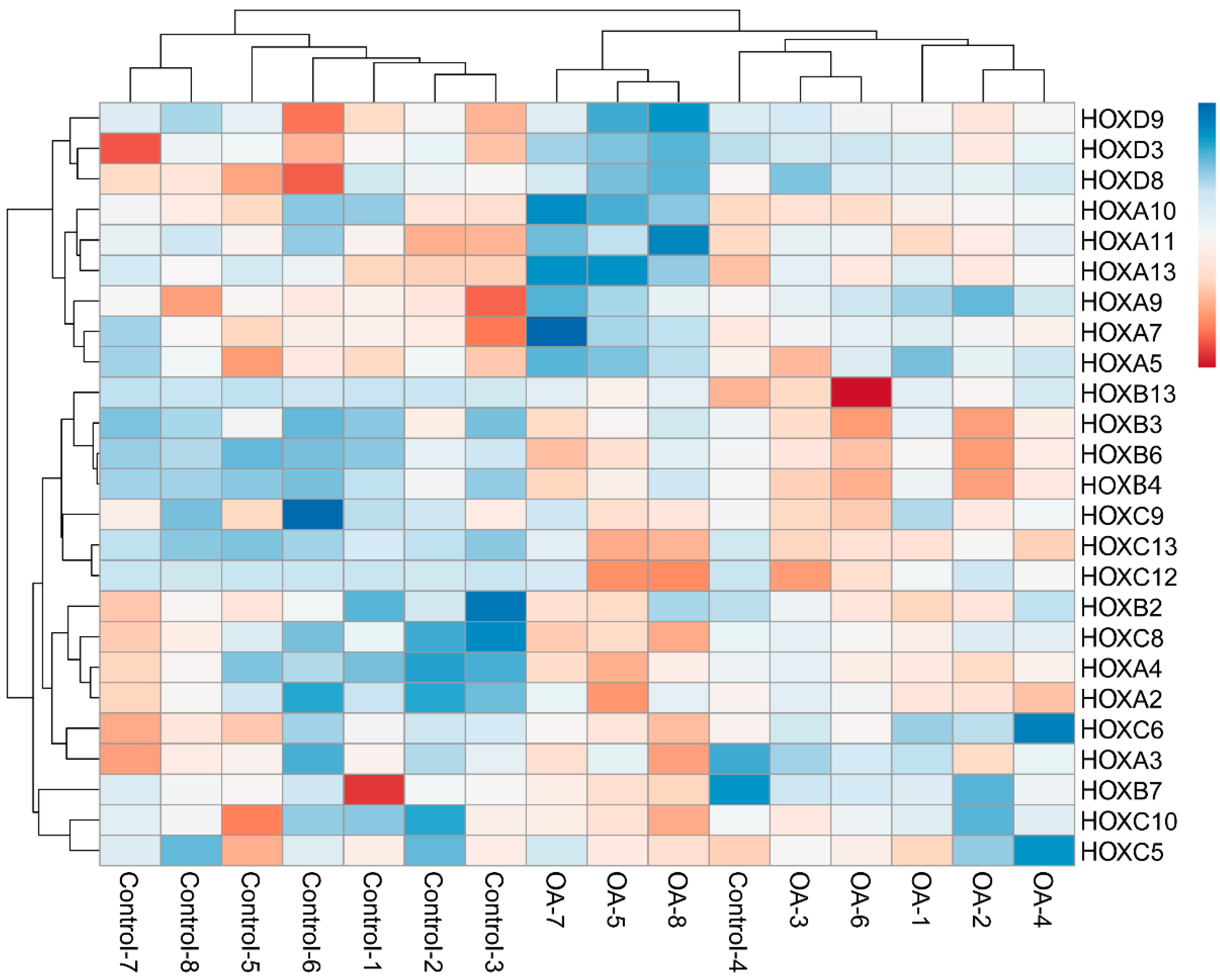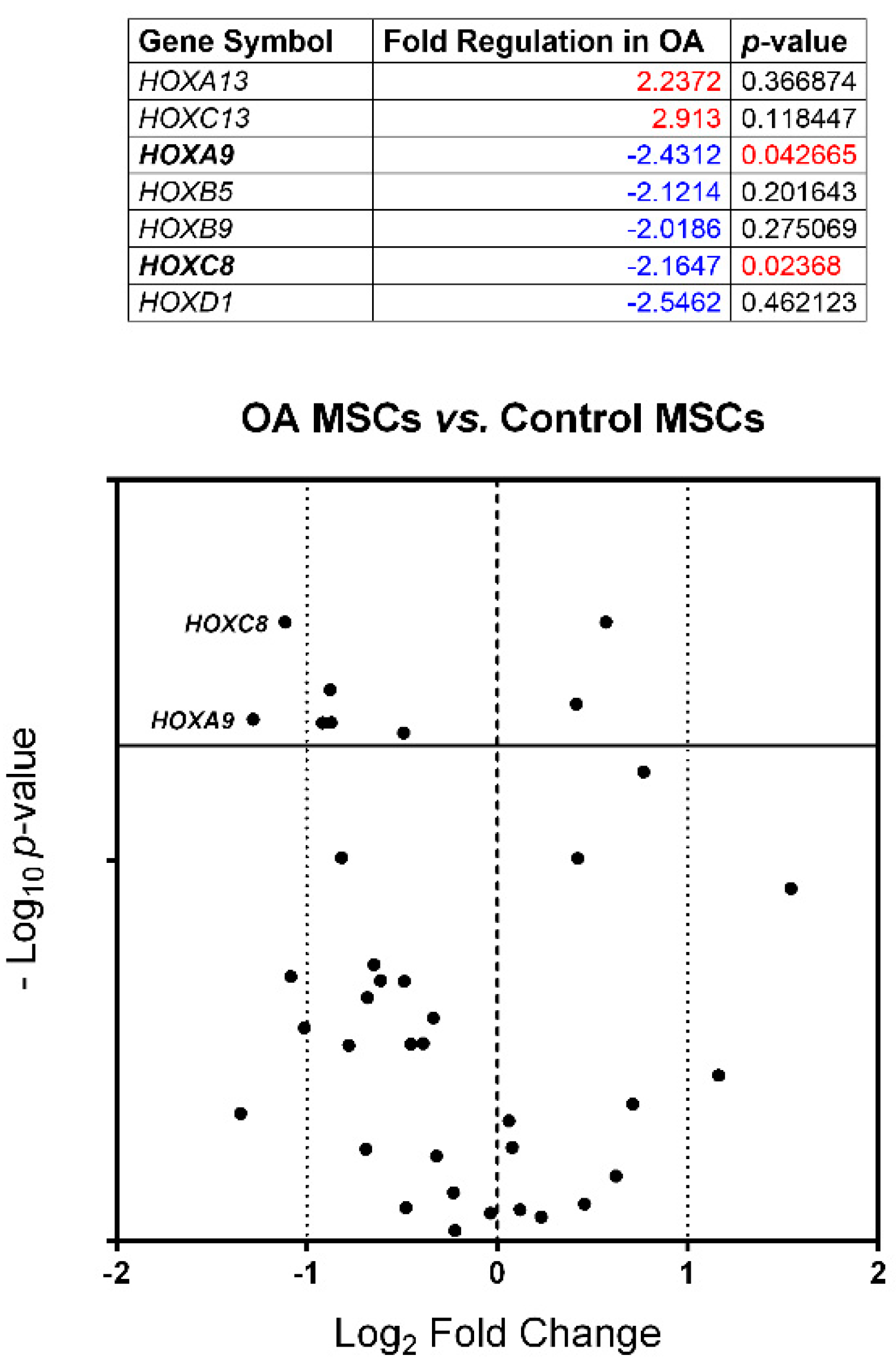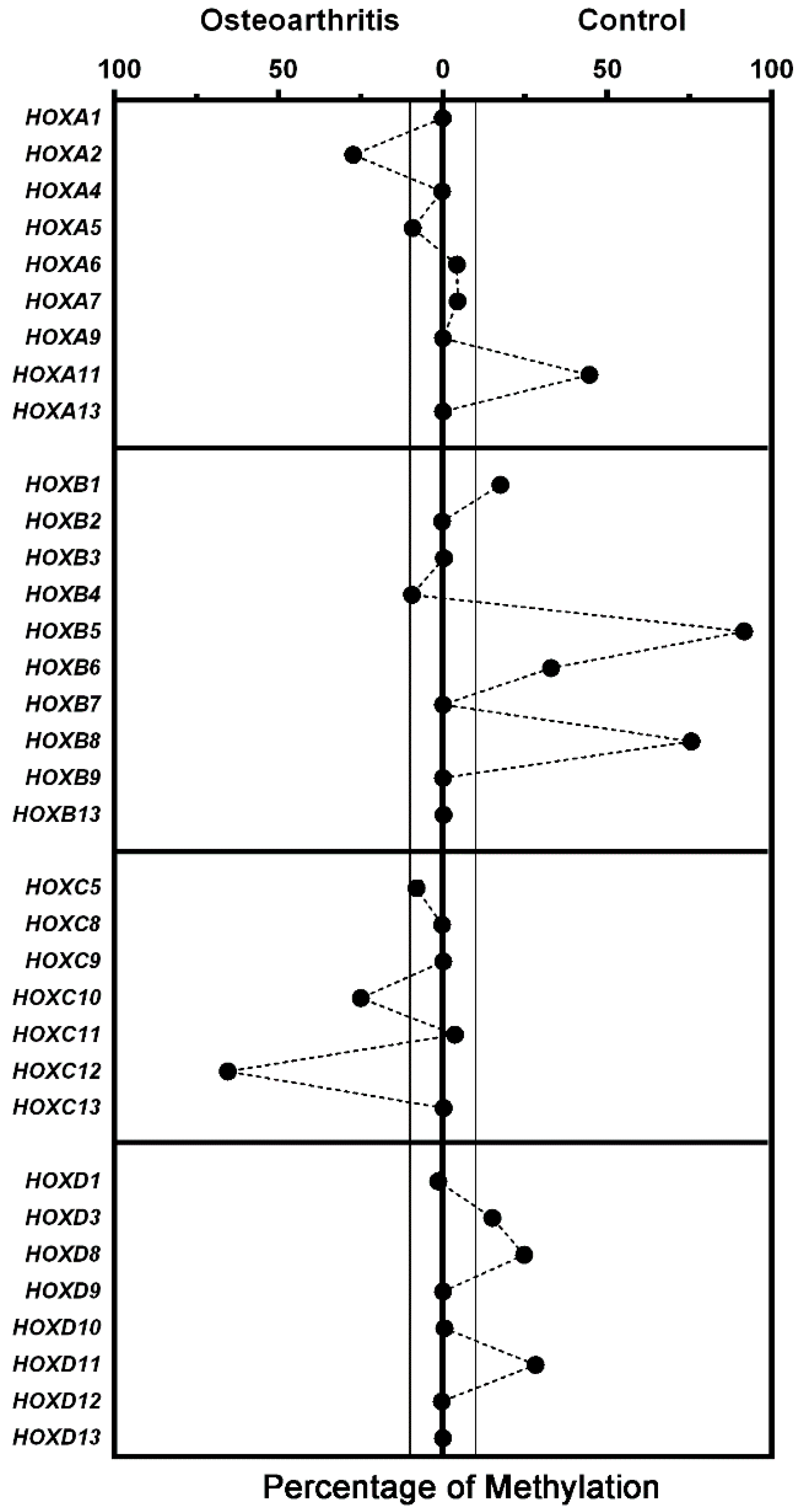Differential Expression of HOX Genes in Mesenchymal Stem Cells from Osteoarthritic Patients Is Independent of Their Promoter Methylation
Abstract
:1. Introduction
2. Materials and Methods
2.1. Array Data Analysis
2.2. Patients
2.3. Cell Cultures
2.4. Cell Characterization
2.4.1. Flow Cytometry
2.4.2. Histochemistry
2.5. Determination of Human HOX Gene Expression by RT-PCR
2.6. Measurement of HOX Genes Promoter Methylation
2.7. Statistical Analysis
3. Results
3.1. Microarray-Based Gene Expression Analysis Reveals the Lower Expression of HOX Genes in OA-MSCs
3.2. Identification of HOX Gene Biological Function Signatures Enriched in MSCs
3.3. Determination of Specific HOX Expression Pattern by RT-PCR
3.4. Epigenetic Methylation Status of HOX Gene Promoters
4. Discussion
5. Conclusions
Supplementary Materials
Author Contributions
Funding
Conflicts of Interest
References
- Litwic, A.; Edwards, M.H.; Dennison, E.M.; Cooper, C. Epidemiology and burden of osteoarthritis. Br. Med. Bull. 2013, 105, 185–199. [Google Scholar] [CrossRef] [PubMed] [Green Version]
- Panoutsopoulou, K.; Zeggini, E. Advances in osteoarthritis genetics. J. Med. Genet. 2013, 50, 715–724. [Google Scholar] [CrossRef] [PubMed] [Green Version]
- Sandell, L.J. Etiology of osteoarthritis: Genetics and synovial joint development. Nat. Rev. Rheumatol. 2012, 8, 77–89. [Google Scholar] [CrossRef] [PubMed]
- Loughlin, J. Genetic contribution to osteoarthritis development: Current state of evidence. Curr. Opin. Rheumatol. 2015, 27, 284–288. [Google Scholar] [CrossRef] [PubMed]
- Kawaguchi, H. Endochondral ossification signals in cartilage degradation during osteoarthritis progression in experimental mouse models. Mol. Cells 2008, 25, 1–6. [Google Scholar] [PubMed]
- Li, G.; Yin, J.; Gao, J.; Cheng, T.S.; Pavlos, N.J.; Zhang, C.; Zheng, M.H. Subchondral bone in osteoarthritis: Insight into risk factors and microstructural changes. Arthritis Res. Ther. 2013, 15, 223. [Google Scholar] [CrossRef] [PubMed]
- Roman-Blas, J.A.; Herrero-Beaumont, G. Targeting subchondral bone in osteoporotic osteoarthritis. Arthritis Res. Ther. 2014, 16, 494. [Google Scholar] [CrossRef] [PubMed]
- Rahmati, M.; Mobasheri, A.; Mozafari, M. Inflammatory mediators in osteoarthritis: A critical review of the state-of-the-art, current prospects, and future challenges. Bone 2016, 85, 81–90. [Google Scholar] [CrossRef]
- Malemud, C.J. Biologic basis of osteoarthritis: State of the evidence. Curr. Opin. Rheumatol. 2015, 27, 289–294. [Google Scholar] [CrossRef]
- Zhang, W.; Ouyang, H.; Dass, C.R.; Xu, J. Current research on pharmacologic and regenerative therapies for osteoarthritis. Bone Res. 2016, 4, 15040. [Google Scholar] [CrossRef] [Green Version]
- Campbell, K.A.; Saltzman, B.M.; Mascarenhas, R.; Khair, M.M.; Verma, N.N.; Bach, B.R., Jr.; Cole, B.J. Does intra-articular platelet-rich plasma injection provide clinically superior outcomes compared with other therapies in the treatment of knee osteoarthritis? A systematic review of overlapping meta-analyses. Arthroscopy 2015, 31, 2213–2221. [Google Scholar] [CrossRef] [PubMed]
- Matta, C.; Khademhosseini, A.; Mobasheri, A. Mesenchymal stem cells and their potential for microengineering the chondrocyte niche. EBioMedicine 2015, 2, 1560–1561. [Google Scholar] [CrossRef] [PubMed] [Green Version]
- Gazdic, M.; Volarevic, V.; Arsenijevic, N.; Stojkovic, M. Mesenchymal stem cells: A friend or foe in immune-mediated diseases. Stem Cell Rev. 2015, 11, 280–287. [Google Scholar] [CrossRef] [PubMed]
- Tanaka, Y. Human mesenchymal stem cells as a tool for joint repair in rheumatoid arthritis. Clin. Exp. Rheumatol. 2015, 33 (Suppl. 92), 58–62. [Google Scholar]
- Rux, D.R.; Wellik, D.M. Hox genes in the adult skeleton: Novel functions beyond embryonic development. Dev. Dyn. 2017, 246, 310–317. [Google Scholar] [CrossRef] [PubMed]
- Mackie, E.J.; Ahmed, Y.A.; Tatarczuch, L.; Chen, K.S.; Mirams, M. Endochondral ossification: How cartilage is converted into bone in the developing skeleton. Int. J. Biochem. Cell Biol. 2008, 40, 46–62. [Google Scholar] [CrossRef]
- McGinnis, W.; Garber, R.L.; Wirz, J.; Kuroiwa, A.; Gehring, W.J. A homologous protein-coding sequence in Drosophila homeotic genes and its conservation in other metazoans. Cell 1984, 37, 403–408. [Google Scholar] [CrossRef]
- McGinnis, W.; Krumlauf, R. Homeobox genes and axial patterning. Cell 1992, 68, 283–302. [Google Scholar] [CrossRef]
- Procino, A.; Cillo, C. The HOX genes network in metabolic diseases. Cell Biol. Int. 2013, 37, 1145–1148. [Google Scholar] [CrossRef]
- Shah, N.; Sukumar, S. The Hox genes and their roles in oncogenesis. Nat. Rev. Cancer 2010, 10, 361–371. [Google Scholar] [CrossRef]
- Pelttari, K.; Barbero, A.; Martin, I. A potential role of homeobox transcription factors in osteoarthritis. Ann. Transl. Med. 2015, 3, 254. [Google Scholar] [CrossRef] [PubMed]
- Boulet, A.M.; Capecchi, M.R. Multiple roles of Hoxa11 and Hoxd11 in the formation of the mammalian forelimb zeugopod. Development 2004, 131, 299–309. [Google Scholar] [CrossRef] [PubMed]
- Lamas, J.R.; Rodriguez-Rodriguez, L.; Vigo, A.G.; Alvarez-Lafuente, R.; Lopez-Romero, P.; Marco, F.; Camafeita, E.; Dopazo, A.; Callejas, S.; Villafuertes, E.; et al. Large-scale gene expression in bone marrow mesenchymal stem cells: A putative role for COL10A1 in osteoarthritis. Ann. Rheum. Dis. 2010, 69, 1880–1885. [Google Scholar] [CrossRef] [PubMed]
- Godfrey, T.C.; Wildman, B.J.; Beloti, M.M.; Kemper, A.G.; Ferraz, E.P.; Roy, B.; Rehan, M.; Afreen, L.H.; Kim, E.; Lengner, C.J.; et al. The microRNA-23a cluster regulates the developmental HoxA cluster function during osteoblast differentiation. J. Biol. Chem. 2018, 293, 17646–17660. [Google Scholar] [CrossRef] [PubMed]
- Simon, T.C.; Jeffries, M.A. The Epigenomic Landscape in Osteoarthritis. Curr. Rheumatol. Rep. 2017, 19, 30. [Google Scholar] [CrossRef]
- Subramanian, A.; Tamayo, P.; Mootha, V.K.; Mukherjee, S.; Ebert, B.L.; Gillette, M.A.; Paulovich, A.; Pomeroy, S.L.; Golub, T.R.; Lander, E.S.; et al. Gene set enrichment analysis: A knowledge-based approach for interpreting genome-wide expression profiles. Proc. Natl. Acad. Sci. USA 2005, 102, 15545–15550. [Google Scholar] [CrossRef] [Green Version]
- Freitag, J.; Bates, D.; Boyd, R.; Shah, K.; Barnard, A.; Huguenin, L.; Tenen, A. Mesenchymal stem cell therapy in the treatment of osteoarthritis: Reparative pathways, safety and efficacy—A review. BMC Musculoskelet. Disord. 2016, 17, 230. [Google Scholar] [CrossRef]
- Nie, Y.; Lau, C.; Lie, A.; Chan, G.; Mok, M. Defective phenotype of mesenchymal stem cells in patients with systemic lupus erythematosus. Lupus 2010, 19, 850–859. [Google Scholar] [CrossRef]
- Li, J.; Yang, S.; Lu, S.; Zhao, H.; Feng, J.; Li, W.; Ma, F.; Ren, Q.; Liu, B.; Zhang, L.; et al. Differential gene expression profile associated with the abnormality of bone marrow mesenchymal stem cells in aplastic anemia. PLoS ONE 2012, 7, e47764. [Google Scholar] [CrossRef]
- Lei, H.; Wang, H.; Juan, A.H.; Ruddle, F.H. The identification of Hoxc8 target genes. Proc. Natl. Acad. Sci. USA 2005, 102, 2420–2424. [Google Scholar] [CrossRef] [Green Version]
- Goncalves, C.S.; Xavier-Magalhaes, A.; Pojo, M.; Oliveira, A.I.; Correia, S.; Reis, R.M.; Sousa, N.; Rocha, M.; Costa, B.M. Transcriptional profiling of HOXA9-regulated genes in human glioblastoma cell models. Genom. Data 2015, 5, 54–58. [Google Scholar] [CrossRef] [PubMed] [Green Version]
- Mallo, M.; Alonso, C.R. The regulation of Hox gene expression during animal development. Development 2013, 140, 3951–3963. [Google Scholar] [CrossRef] [PubMed] [Green Version]
- Wu, H.; Gordon, J.A.; Whitfield, T.W.; Tai, P.W.; van Wijnen, A.J.; Stein, J.L.; Stein, G.S.; Lian, J.B. Chromatin dynamics regulate mesenchymal stem cell lineage specification and differentiation to osteogenesis. Biochim. Biophys. Acta 2017, 1860, 438–449. [Google Scholar] [CrossRef] [PubMed] [Green Version]
- Bork, S.; Pfister, S.; Witt, H.; Horn, P.; Korn, B.; Ho, A.D.; Wagner, W. DNA methylation pattern changes upon long-term culture and aging of human mesenchymal stromal cells. Aging Cell 2010, 9, 54–63. [Google Scholar] [CrossRef] [PubMed]



© 2018 by the authors. Licensee MDPI, Basel, Switzerland. This article is an open access article distributed under the terms and conditions of the Creative Commons Attribution (CC BY) license (http://creativecommons.org/licenses/by/4.0/).
Share and Cite
Mucientes, A.; Herranz, E.; Moro, E.; Lajas, C.; Candelas, G.; Fernández-Gutiérrez, B.; Lamas, J.R. Differential Expression of HOX Genes in Mesenchymal Stem Cells from Osteoarthritic Patients Is Independent of Their Promoter Methylation. Cells 2018, 7, 244. https://doi.org/10.3390/cells7120244
Mucientes A, Herranz E, Moro E, Lajas C, Candelas G, Fernández-Gutiérrez B, Lamas JR. Differential Expression of HOX Genes in Mesenchymal Stem Cells from Osteoarthritic Patients Is Independent of Their Promoter Methylation. Cells. 2018; 7(12):244. https://doi.org/10.3390/cells7120244
Chicago/Turabian StyleMucientes, Arkaitz, Eva Herranz, Enrique Moro, Cristina Lajas, Gloria Candelas, Benjamín Fernández-Gutiérrez, and José Ramón Lamas. 2018. "Differential Expression of HOX Genes in Mesenchymal Stem Cells from Osteoarthritic Patients Is Independent of Their Promoter Methylation" Cells 7, no. 12: 244. https://doi.org/10.3390/cells7120244
APA StyleMucientes, A., Herranz, E., Moro, E., Lajas, C., Candelas, G., Fernández-Gutiérrez, B., & Lamas, J. R. (2018). Differential Expression of HOX Genes in Mesenchymal Stem Cells from Osteoarthritic Patients Is Independent of Their Promoter Methylation. Cells, 7(12), 244. https://doi.org/10.3390/cells7120244




